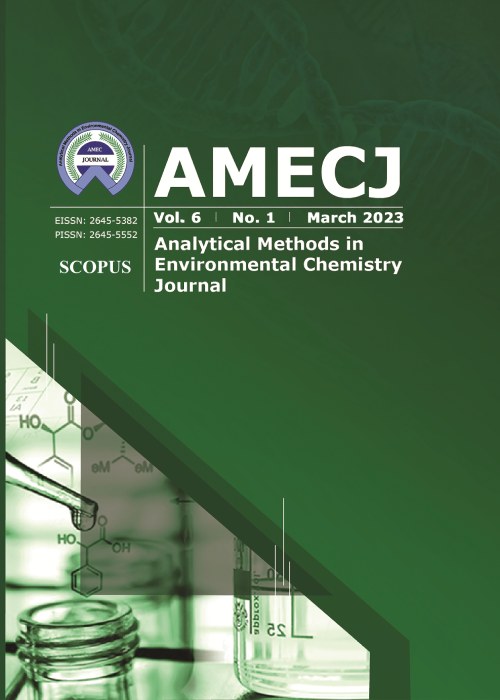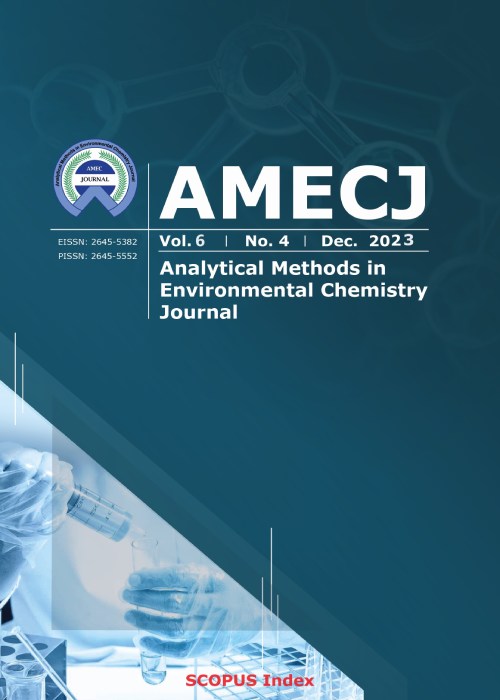فهرست مطالب

Analytical Methods in Environmental Chemistry Journal
Volume:6 Issue: 1, Mar 2023
- تاریخ انتشار: 1402/01/09
- تعداد عناوین: 7
-
Pages 5-16
This s tudy focused on the adsorption behavior of the cationic Crys tal Violet (CV) dye from aqueous solutions using a Co+2‒hectorite composite as an adsorbent surface. The initial and equilibrium CV dye concentrations were determined using a UV-Vis spectrophotometer. The results were discussed and presented for the impacts of pH, primary CV dye concentration, composite dosage, and temperature. The optimum conditions were found for eliminating Crys tal Violet dye from the aqueous solution at a pH 4, ideal temperature 293 K, and 0.5 g L-1 of composite dose. The pseudo-second-order kinetic, intraparticle diffusion analyzed the tes ts’ data and film diffusion models. Each model’s defining features have been identified, and these models were in good agreement and in charge of regulating the adsorption reaction. The adsorption operation was also thermodynamically examined to determine thermodynamic variables such as Gibbs free energy (ΔGo), entropy (ΔSo), activation energy (Ea), and enthalpy (ΔHo). The negative value of Gibbs free energy (ΔGo) and enthalpy (ΔHo) indicated that the adsorption process was a spontaneous and exothermic reaction. While the activation energy (Ea) data which fell within the normal range for physisorption, was discovered to be 22.434 kJ mol-1. This result proved that physical adsorption occurs between the CV dye and the adsorbent surface (Co+2‒hectorite composite).
Keywords: Adsorption, UV-Vis spectrophotometer, Crys tal violet, Isotherm, Thermodynamics, Kinetics -
Preparation of recycled poly s tyrene derivatives to remove heavy metal ions from contaminated waterPages 17-28
In recent years, numerous researchers have concentrated on the process of turning wa s te into usable materials. Poly s tyrene and its modifications have received great attention over the pa s t few decades due to their out s tanding ion exchange behavior toward various toxic heavy metals in aqueous solutions. Therefore, this s tudy is concerned with the preparation of three different cationic polymeric resins for the removal of Pb2+, Cd2+, and Fe3+ heavy metal ions from their contaminated water samples based on the sulfonated singleused poly s tyrene teacup wa s te (SPS), which was used to prepare sulfonated poly s tyrene-g-acrylamide monomer (SPS-g-Acryl) and sulfonated poly s tyrene-g-chitosan (SPS-g-Chit) using commercial chitosan (DD=85%) originally extracted from shrimp cortex. The concentrations of the selected heavy metal ions were measured before and after each experiment with a flame atomic absorption spectrometer (F-AAS). The analytical s tudies s tarted by exploring the influence of pH (2, 4, 6, and 8) on removing the heavy metal ions Pb2+, Cd2+, and Fe3+ from their aqueous solutions. The obtained results revealed that as the pH of the analyzed ion solution is increased, the removal efficiency for ions increases. All three resins (SPS, SPSg- Acryl, and SPS-g-Chit) had different removal efficiencies for the inve s tigated ions, with SPS-g-Chit resin being the be s t in both batching and column loading methods, and they could be compared in the following order: SPS-g-Chit > SPS-g-Acryl > SPS, and it could be reused after regeneration.
Keywords: Sulfonated poly s tyrene, Chitosan, Grafting, Acrylamide, Heavy metals, Flame atomic absorption spectrometer -
Pages 29-57
Arsenic is a highly toxic metalloid that forms different chemical s tates in nature, including arsenate and arsenite, as common inorganic forms. Exposure to arsenic may cause adverse effects on human health and the environment. Therefore, the detection of arsenic is critical. Exploring new approaches with low detection ranges and high sensitivity is crucial. This review paper consi s ts of optical methods, including colorimetric and fluorometric methods, which detect arsenite and arsenate (μg L-1). Initially proposed colorimetric approaches such as the Gutzeit and molybdenum blue method can easily to use. However, the production of toxic sub s tances limits their applications. Later, s tructurally modified molecules, nanoparticlebased assays, and their modifications are used for arsenic detection. Fluorometric methods also have noticeable attention to arsenic detection. Fluorescent approaches reported in this paper are based on semiconductor nanomaterials, other nanomaterials, and their modifications, etc. In addition, arsenate’s catalytic and inhibitory activity on enzyme activity can be used to detect arsenic through colorimetric and fluorometric methods. This review highlighted the advantages, disadvantages, comparisons, and uses of colorimetric and fluorometric methods in detecting arsenite and arsenate.
Keywords: Arsenate, Arsenite, Colorimetric, Fluorometric, Nanoparticles -
Pages 58-68
The behavior of phenol was s tudied and determined using the modified carbon pa s te electrode (MCPE) with nickel oxide nanoparticles doped by nitrogen carbon quantum dots as nanoadsorbent (NiO-NCQD) and cyclic voltammetry (CV). The MCP electrode was manufactured in a laboratory. The modified carbon pa s te consi s ted of 12% (NiONCQD), 44% of graphite powder and 44% of paraffin oil to get a modified carbonate pa s te. Cyclic voltammetry can provide behavior information; as such: diffusion coefficient (D), charge transfer coefficient (α.nα), the mass transport (mtrans) found that diffusion coefficient, the reducing of mass transport (mtrans) by increasing the phenol concentration in the solution, and increasing of con s tant K0 when the concentration of phenol increased in the solution. Also, the highe s t occupied molecular orbital (HOMO), lowe s t unoccupied molecular orbital (LUMO), and Gibbs free energy (ΔG) are s tudied and calculated. In this s tudy, EHOMO=4.92eV, ELUMO=0.32eV, and ΔG=-4.17 were considered. The drinking water samples from Latakia city were analyzed based on NiO-NCQD adsorbent using the MCPE method (NiO-NCQD/MCPE). The phenol concentration in the drinking water sample in Latakia was achieved less than the quantitative detection limit (LOQ), and the proposed procedure was validated by spiking samples.
Keywords: Phenol, Cyclic voltammetry, Modified carbon pas te electrode, Nickel oxide nanoparticles, Nitrogen carbon quantum dots, Kinetic -
Pages 69-78
In the la s t few years, using chemical insecticides to control the malaria vector has caused environmental pollution and resi s tance to chemical insecticides. This s tudy aimed to inve s tigate the chemical analysis of essential oils of Thymus carmanicus Jalas by gas chromatography and mass spectrometry (GC-MS) and toxicity activity again s t the major Iranian malaria vector, Anopheles s tephensi. The essential oil of Thymus carmanicus Jalas was prepared from dried leaves using the hydro-di s tillation method. Gas chromatography mass spectrometer (GC-MS) was used to analyze and identify thyme essential oil compounds. Bioassay was performed using World Health Organization (WHO) s tandard te s t. The T. Carmanicus Jalas essential oil consi s ted of 15 compounds, with Carvacrol (61%), Thymol (6%), and β-caryophyllene (5%) being the major components by volume. The LC50 and LC90 of thyme oil were 20.37 and 41.38 mg L-1 at 24h after application, respectively. At 24h after application, significant differences were observed between the toxicity of 5%, 20%, 25%, 40%, 50%, and 80% concentrations of Thyme essential oil (P<0.05). The 80% concentration of Thyme essential oil exhibited 100% toxicity again s t A. s tephensi larvae at 24h after application. T. Carmanicus has a rich source of bioactive compounds for use as a mosquito larvicide.
Keywords: Chemical analysis, Gas chromatography-massspectrometry, Thymus Carmanicus Jalas, Essential oil, Malaria -
Pages 79-99
The continuous exposure of the environment to carcinogenic wa s tes and toxic chlorophenols such as pentachlorophenol (PCP) and 2,4,6-trichlorophenol (TCP) resulting from indu s trial production activities has become a great concern to research scienti s ts and environmental policymakers. The search for a co s t-efficient and eco-friendly approach to the phytoremediation of water will guarantee su s tainability. The present research concerns the co s tbenefit evaluation and the optimization modeling of the competitive biosorption of PCP and TCP from aqueous solution to Cana indica. L (CiL-plant) using response surface methodology (RSM) , artificial neural network (ANN) model, and UV-Vis Spectrometry. The predictive performances of the ANN model and the RSM were compared based on their s tati s tical metrics. The antagoni s tic and synergetic effects of significant biosorption variables (pH, initial concentration, and exposure time) on biosorption were s tudied at p-values ≤0.005. The findings from the phytoremediation process confirmed that PCP and TCP removal rate reached equilibrium at the optimum conditions corresponding to predominantly acidic pH (4), required initial concentration of 50 mg L-1, and exposure time of 25 days in aquaponia. The optimized output transcends to PCP and TCP removal rates of 90% and 87.99% efficiencies at predicted r-squared ≤0.9999 and a 95% confidence interval. The co s t-benefit evaluation e s tablished that at the optimum conditions, the co s t of operating the removal of TCP from the aqueous solution would save $ 7.72 compared to PCP. The optimization model’s reliability based on the experiment’s (DoE) design was more su s tainable than the one-factorat- a-time (OFAT) methodologies reported in previous research.
Keywords: Phytoremediation, UV-Vis spectrometry, Chlorophenol biosorption, Canna Indica L plant, ANN modeling, RSM optimization -
Pages 100-114
The present s tudy aimed to extract pes ticide residues in the field and greenhouse-grown tomatoes and homemade pas te based on the quick, easy, cheap, effective, rugged, and safe sample preparation method (QuEChERS) before determined by the liquid chromatography-mass spectrometry (LC-MS). The mean difference in percentage reduction of deltamethrin (DLM) and acetamiprid (ACT) in raw tomatoes of greenhouse-grown was obtained at 91.42 and 90.00%, respectively, which was insignificantly more than filed condition (84.91% and 86.34%). Maximum reduction percentages of the DLM in pas te under greenhouse and field tomato conditions were achieved by more than 95.86% and 93.11%, respectively. The residual concentration of both DLM (91.42%) and ACT (90.00%) in the greenhouse decreased more than the field (84.91% and 86.34%), respectively. Abamectin(ABA) reached below the MRL in a shorter time after spraying (2 days). Considering the pre-harves t interval (PHI) period of deltamethrin and abamectin can reach their residual concentration to the MRL in both conditions, which were determined by LC-MS. According to the results of the current s tudy, 7 and 5 days can be sugges ted as the PHI period of the acetamiprid for field and greenhouse-grown tomatoes, respectively. Therefore, using pes ticides in the proper dosage, considering appropriate PHI, and harves ting can reduce their residues in agricultural products.
Keywords: Liquid chromatography-massspectrometry, Analysis, QuEChERS method, Pes ticide residues, Field, Greenhouse-grown tomatoes


